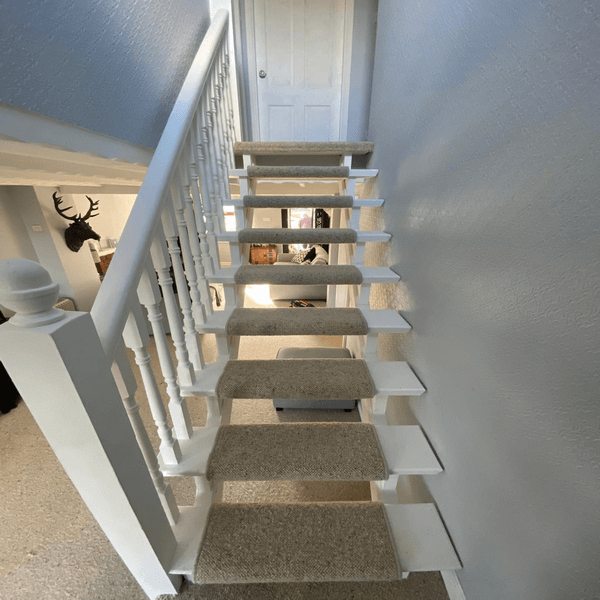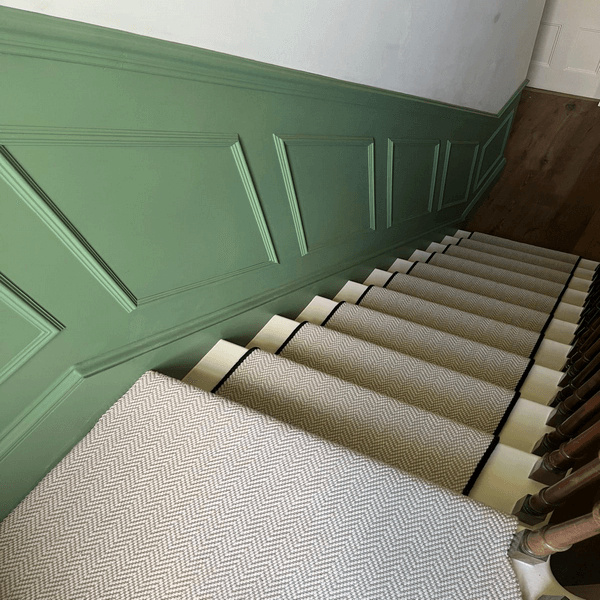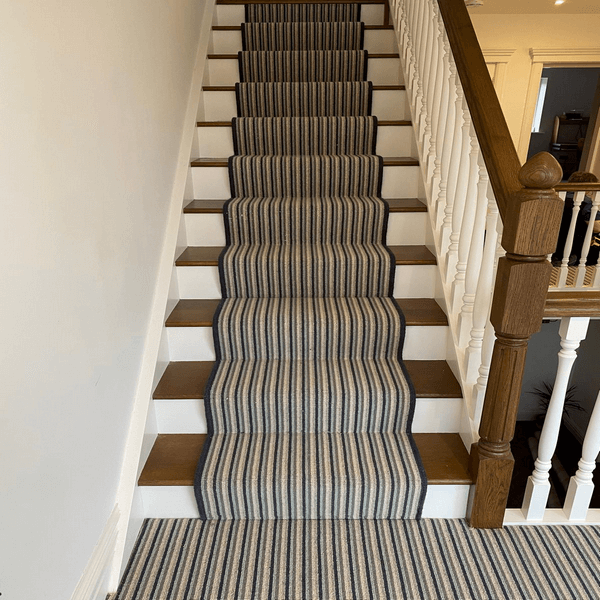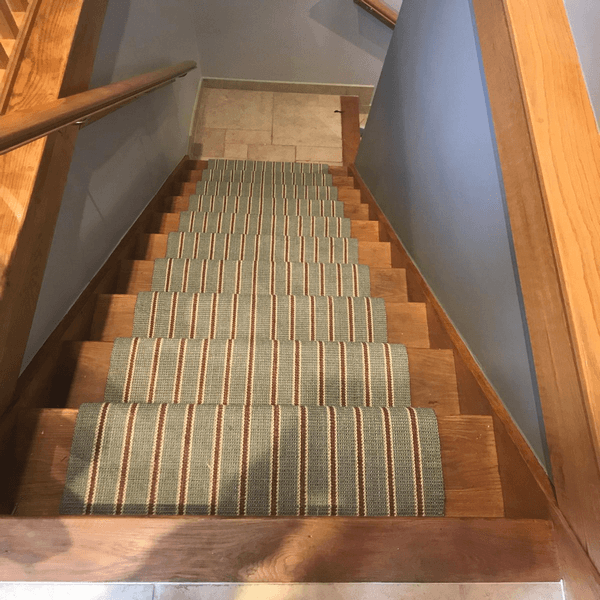Table of Contents
Your staircase should be more than just a way to get upstairs. It’s one of the first things people notice when they enter your home, so why not make it both beautiful and safe?
Stair runners combine style and safety like few other home additions can. These practical carpet strips provide reliable traction—keeping you and your family safe from slips and falls—whilst protecting your staircase from daily wear and tear. This safety feature becomes particularly important if you have young children, elderly family members or anyone with balance challenges in your home.
Whether you’re after carpet runners that make a bold design statement or subtle options that blend seamlessly with your décor, the right choice offers benefits you might not expect. Quality stair runners reduce noise by dampening footsteps, cushion against potential falls and shield your stair treads from damage. Plus, with endless colours, patterns and materials available, they can visually extend your staircase whilst adding personality to an often overlooked area of your home.
Don’t forget, you can create this stunning look in just a weekend. Ready to discover everything you need to know about selecting the perfect stair runner that balances both function and style?
What should you consider before choosing your stair runner?
Before falling in love with a gorgeous pattern or colour, take a moment to think about what your home actually needs. Your perfect stair runner should work as hard as it looks good—and that means considering some practical factors first.
Why does safety matter most?
Safety should top your list, especially if you share your home with young children or elderly family members. Bare staircases, particularly those with polished or slick surfaces, create serious slip hazards. Stair runners add that crucial grip you need, reducing the likelihood of dangerous falls. They also provide cushioning that absorbs impact—potentially preventing serious injuries during accidental slips.
For homes with elderly residents, carpet runners offer benefits you might not expect. They reduce joint strain by absorbing shock, enhance stair edge visibility through contrasting borders, and create a more stable walking surface. Children benefit too, as the non-slip surface prevents those common “slippery socks” mishaps that often end in tumbles.
How much traffic do your stairs see?
Think about how often your stairs get used throughout the day. High-traffic staircases need materials specifically designed to handle constant use without showing wear. Here’s something interesting—foot traffic actually has a greater impact on stairs than on flat areas due to increased gravitational force when you’re heading down.
For busy households, you’ll want:
- Loop pile or low-pile textures that offer durability and stability
- Twist pile carpets that resist showing marks and scuffs
- Materials like wool that maintain their appearance despite heavy use
Remember, descending stairs places more pressure on carpet fibres than walking on flat surfaces, making durability particularly important here.
What’s a realistic budget for your project?
Setting a realistic budget helps narrow down your options whilst ensuring you don’t compromise on quality. Expect to pay between £15 and £35 per linear foot for the runner itself, with an average staircase requiring approximately 22 linear feet (total cost: £330-£725). Custom edging will add £2-£4.50 per linear foot to your budget.
Installation costs vary depending on your staircase—approximately £200-£300 for straight stairs and £300-£375 for staircases with turns or landings. Your total investment typically ranges from £600 for a standard installation to £1,700 for more complex designs.
Despite the investment, a quality stair runner protects your staircase from wear and tear whilst enhancing safety—making it worthwhile for most homes.
What are the stair runner trends worth shouting about?
Your staircase presents the perfect opportunity to make a show-stopping statement. With the right runner, you can take this functional space and turn it into a stunning focal point that reflects your personality whilst enhancing your home’s interior.

Embrace timeless herringbone patterns
Herringbone patterns remain one of the most loved designs for stair runners, offering classic elegance that works beautifully whether you live in a period property or contemporary home. This zigzag pattern adds visual interest without overwhelming your space—perfect for creating that ‘wow factor’ guests will remember.
Want something bolder? Geometric patterns bring dynamic energy to an otherwise simple staircase, instantly shifting your interior’s mood without touching floors or walls. These statement-making designs effectively hide wear and tear whilst adding bags of character to your home.
Bring nature indoors with organic textures
For those who prefer a more natural aesthetic, jute-style and sisal runners add gorgeous texture and an organic feel. They’re perfect for pairing with natural accents like woven baskets or wooden furniture—creating that relaxed, earthy vibe that’s so popular right now.
Create sophistication with modern minimalism
Contemporary homes love minimalist stair runners with clean lines and subtle textures. Neutral tones such as cream, white, and beige never go out of style and blend seamlessly with any interior scheme. But don’t think neutral means boring—vibrant colours are making a comeback, with homeowners embracing everything from rich berry tones to striking emeralds.
Two-toned luxury runners, particularly in herringbone designs, offer an elegant yet modern approach that works brilliantly in updated traditional homes.
Make narrow staircases look wider with stripes
Striped stair runners work like magic for staircases—they visually extend the appearance and make them look longer. They’re particularly effective for narrow stairs, creating an illusion of width that opens up your space.
Takeaway Tip: Grey striped runners prove incredibly versatile for homes with children and pets, as they cleverly hide dirt and wear between cleans.
Add structure with bordered designs
Bordered runners add clean structure and subtle contrast, giving your steps that finished, tailored look. These borders can be created through contrasting tape edging or woven into the pattern design itself. When selecting borders, consider how they’ll work with your existing décor—whether you want deliberate contrast or subtle coordination.
Showcase your home’s character
Period properties benefit enormously from stair runners that accentuate traditional woodwork rather than hiding it. By leaving portions of your stairs visible, you showcase the craftsmanship whilst still providing comfort underfoot. For minimalist staircases, textured runners draw the eye and create tactile interest that can be both seen and felt.
Remember, your staircase connects every level of your home—injecting it with colour and character through a well-chosen runner will spread joy throughout your entire space.

Which materials will give you the best stair runner?
Selecting the right material for your stair runner determines how well it performs in your home. The perfect carpet runner balances durability against comfort whilst maintaining its appearance despite daily use.
The materials that truly deliver
Wool remains the gold standard for stair runners, offering natural resilience and elasticity that allows it to spring back from compression. This makes wool exceptionally resistant to crushing and furniture marks. Wool provides excellent thermal and acoustic insulation whilst naturally repelling water and oil spills. Although higher priced, wool’s durability in high-traffic areas makes it a worthwhile investment.
Synthetic options offer practical alternatives you shouldn’t overlook:
- Polypropylene delivers exceptional stain resistance and durability whilst remaining soft underfoot
- Nylon provides excellent resilience against heavy foot traffic and maintains its appearance over time
- Polyester offers affordability and good stain resistance, although with less durability than wool or nylon
For eco-conscious homeowners, several sustainable materials perform admirably on staircases. Sisal provides exceptional durability and slip resistance, albeit with less softness. Wool-blend runners combine natural and synthetic fibres for “the best of both worlds”.
Loop pile or cut pile – which suits your stairs?
Loop pile carpets feature uncut yarn loops creating a dense, textured surface. More durable than other options, loop pile resists crushing and matting, making it ideal for stairs. The tight weave hides dirt effectively and withstands heavy foot traffic without showing wear paths. However, loop pile may snag with pet claws and generally feels less plush underfoot.
Cut pile carpets have their loops cut at the tips, creating a soft, luxurious surface. This type excels in comfort and aesthetics, offering a velvety texture that feels sumptuous underfoot. Cut pile shows vacuum marks and footprints more readily, making it better suited for lower-traffic staircases.

Colours that work harder for you
Medium to dark grey remains popular for stair runners because it effectively conceals everyday dirt whilst offering versatile styling options. Earth tones like brown and taupe provide warmth whilst hiding stains, particularly important for busy households.
Multi-toned or patterned carpets confuse the eye, making dirt less noticeable between cleanings. For high-traffic staircases, avoid very light or very dark solid colours—light shows every speck whilst dark carpets reveal lint and pet hair.
Takeaway Tip: hallways and staircases often have limited lighting, so neutral or light coloured runners create a calming atmosphere whilst keeping spaces bright.
Getting your stair runner fitted and keeping it looking fresh
You’ve chosen your perfect stair runner, but proper installation and care will determine how well it performs in your home. The right approach to fitting and maintaining your stair runner makes all the difference to its longevity and appearance.
Should you fit it yourself or call in the professionals?
This decision comes down to your DIY confidence and your staircase’s complexity. Fitting a runner yourself offers serious cost savings, but you’ll need precision and patience. For this route, gather your essential tools: staple gun, carpet tape, and utility knife.
Professional installation brings expertise that proves invaluable for curved staircases or those with tricky landings. Professionals ensure your runner stays securely fastened with no loose edges that could create hazards. Installation costs typically range from £200-£300 for straight stairs and £300-£375 for staircases with turns.
What you’ll need for securing your runner:
- Carpet tape for non-permanent adhesive hold
- Staples or tacks for more permanent security
- Stair rods that combine decorative elements with functionality
- Non-slip underlay that works well for hardwood stairs without leaving marks
Keep your runner looking its best
Regular vacuuming forms the backbone of stair runner maintenance. Use a handheld vacuum or stair attachment at least once weekly, working in the direction of the fibres. Got a busy household or pets? Vacuum twice weekly.
When spills happen (and they will!), blot rather than rub to prevent spreading stains. Apply cleaning solutions to your cloth—never directly to the runner—and work from the stain’s outside inward. Natural solutions like baking soda work brilliantly for neutralising odours; simply sprinkle, leave for 15-30 minutes, then vacuum thoroughly.
Takeaway Tip: Consider professional cleaning every 1-2 years, particularly for wool runners. This removes embedded dirt without damaging natural fibres, extending your runner’s lifespan considerably.
How your runner protects your investment
Beyond looking gorgeous, stair runners create a protective barrier between footwear and stair surfaces. This shield prevents scratches, scuffs and general wear that would otherwise damage wood or stone stairs. Without this protection, direct contact between shoes and stairs causes gradual deterioration requiring costly repairs.
Your runner also absorbs impact from daily foot traffic, reducing structural stress on your staircase over time. This protective quality proves particularly valuable for delicate materials like hardwood that might otherwise show premature ageing from regular use.
Create a stair runner worth shouting about
Choosing the perfect stair runner comes down to balancing your family’s needs with your personal style. You’ve discovered how these practical additions protect your loved ones whilst adding character to your home’s most travelled pathway.
Your material choice makes all the difference to how your runner performs over time. Wool delivers exceptional durability despite the higher investment, whilst synthetic options provide brilliant alternatives without compromising on quality. The key is matching your selection to your household’s daily demands and maintenance preferences.
Don’t treat your staircase as just another functional feature. Whether you’re drawn to classic herringbone patterns or eye-catching geometric designs, your runner can transform this transitional space into a real showstopper. Stripes and borders work particularly well for creating the illusion of length whilst cleverly concealing everyday wear.
Professional fitting might require a bigger initial outlay, but the peace of mind and precision often make it worthwhile—especially for tricky staircases with curves or landings. Regular care through weekly vacuuming and quick attention to spills will keep your investment looking fresh for years to come.

The right stair runner serves as both guardian and decorator for your home. When chosen thoughtfully, this single addition enhances safety, reduces noise, and injects personality into your space.
So why wait? Your perfect stair runner is ready to make your home safer, quieter, and more beautiful—all in one weekend project.
FAQs
Q1. How do I choose the right material for my stair runner? Consider factors like durability, comfort, and maintenance. Wool is excellent for longevity and natural resilience, while synthetics like polypropylene offer good stain resistance. For eco-friendly options, sisal provides durability but less softness. Your choice should balance your household’s needs with your budget.
Q2. What are the benefits of installing a stair runner? Stair runners enhance safety by providing traction, reduce noise from footsteps, protect stairs from wear and tear, and add aesthetic appeal to your home. They’re particularly beneficial for households with children, elderly members, or pets.
Q3. Should I choose a patterned or plain stair runner? This depends on your personal style and practical needs. Patterned runners, like stripes or geometrics, can visually elongate staircases and hide dirt better. Plain runners in neutral tones offer versatility and a timeless look. Consider your home’s overall décor when deciding.
Q4. How much does a quality stair runner typically cost? Expect to pay between £15 and £35 per linear foot for the runner itself. For an average staircase requiring about 22 linear feet, the total cost ranges from £330 to £725. Installation costs vary but typically fall between £200 and £375, depending on staircase complexity.
Q5. How often should I clean my stair runner? Vacuum your stair runner at least once a week, or twice weekly for high-traffic areas or homes with pets. Promptly address spills by blotting, not rubbing. Consider professional cleaning every 1-2 years, especially for wool runners, to maintain their appearance and extend their lifespan.